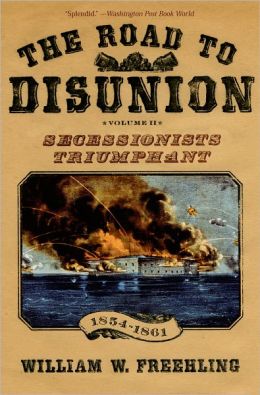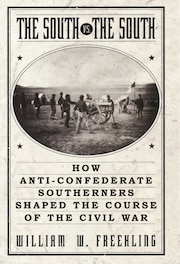
From The New York Times, "The Three Souths," by Eric Foner, on 8 April 2007 --Everyone who lived through the Civil War, Abraham Lincoln observed in his second Inaugural Address, knew that slavery was “somehow” its cause. Ever since, historians have been struggling to explain that “somehow.” Their interpretations fall into two broad schools. One sees the war as the result of an “irrepressible conflict” between two societies with incompatible interests and values. The second blames irresponsible agitators and a “blundering generation” of political leaders for bringing about a war that could and should have been avoided.
In “The Road to Disunion: Secessionists Triumphant,” the conclusion of a two-volume account of the Civil War’s origins, William W. Freehling seems to combine these approaches. It is “indisputable,” he writes, that slavery was the war’s main cause, and some kind of clash was probably inevitable. But not necessarily in 1861. Whatever the underlying reasons, the war that actually took place resulted from individual decisions, chance events and at least one “incredible coincidence.”

THE ROAD TO DISUNION: Volume Two. Secessionists Triumphant: 1854-1861. By William W. Freehling.
Since the publication four decades ago of “Prelude to Civil War,” a study of the nullification crisis of the early 1830s, Freehling has been among the foremost students of 19th-century Southern history. If one theme unites his scholarship it is that the Old South cannot be viewed as a monolith. It contained distinct regions with divergent economic structures and degrees of commitment to slavery. In the seven states of the Lower South, cotton was king and slaves comprised nearly half the population. The Middle South (Virginia, North Carolina, Tennessee and Arkansas) contained large regions of nonslaveholding whites. In the Border South (Delaware, Maryland, Kentucky and Missouri) slavery seemed to be in decline. By 1860, 90 percent of Delaware’s black population and half of Maryland’s were already free.
Time and again, Freehling writes, the three Souths collided. In the three months following Lincoln’s election, the entire Lower South seceded. The Middle South waited, hoping for compromise; it joined the Confederacy only after the firing on Fort Sumter. The four border states not only remained in the Union but furnished thousands of troops to help defeat their Southern brethren.

As Freehling shows, this disunity long preceded 1861. In crisis after crisis, advocates of secession faced a “double enemy” — Northerners hostile to slavery and white Southerners willing to compromise with their foes. “Secessionists Triumphant” begins in 1854, when the question of slavery’s westward expansion moved to the center stage of national politics and ends 500 pages later with the outbreak of war. Many of the subjects Freehling covers — Bleeding Kansas, the Dred Scott decision, John Brown’s raid — are well known; others, like the movement to reopen the African slave trade, will be new even to many specialists. But by keeping his eye fixed on the problem of Southern disunity, he manages to offer original insights on even the most familiar topics.
Freehling examines how, in the 1850s, the Lower South became more and more committed to defending slavery as a positive good. At the same time, he tells us, the Middle and Border Souths persisted in the dream of eventually removing all slaves (and free blacks) from the region and reorienting its economy toward the North. Secessionists were not wrong, he writes, to see these states as slavery’s Achilles’ heel.

The movements in the 1850s to acquire new slave territories for the United States, reopen the African slave trade and re-enslave free blacks also revealed Southern disunity. Freehling offers fascinating accounts of each. But his main point is that because of opposition within the South, all failed. Even South Carolina, he shows, was divided. In his account of the aftermath of Lincoln’s election, Freehling overturns the conventional picture of a state rushing headlong into disunion. South Carolina secessionists emerge instead as a beleaguered minority, fearful that their state would stand alone (as it had during the nullification crisis).

At this point, Freehling’s “incredible coincidence” comes into play. A railroad had just been completed linking Savannah, Ga., and Charleston, S.C. As the South Carolina legislature deliberated, leading citizens of the two cities took part in a celebration. The Georgians, carried away by the emotion of the moment, pledged their state’s support for secession. Suddenly convinced that other states would follow, the legislature moved the secession convention up to December. The “coincidence,” Freehling argues, changed history. Had South Carolina not taken this step, Unionists might have prevailed throughout the South.
Whatever one thinks of this excursion into counterfactual history (and the argument seems dubious to me), Freehling’s overall emphasis on the role of contingency in history offers genuine insights. But it comes at a cost. It has become fashionable of late for historians writing with one eye on the best-seller list to disparage fellow scholars for supposedly alienating the broad reading public. Unlike “academic historians,” Freehling proclaims, he tells “stories about striking individuals” and their unpredictable impact on history.
There is no question that “Secessionists Triumphant” is peopled by a colorful cast of characters, from William L. Yancey, a hotheaded secessionist who tried to inspire Southerners with a sense of nationhood, to James Henry Hammond, a South Carolina planter who preyed on his female slaves. But Freehling’s fondness for individual stories puts undue emphasis on psychological explanations, with words like “frustration” and “rage” sprinkling the text. Moreover, the attempt to assume a popular literary style often seems forced. (Was the pro-slavery theorist George Fitzhugh really dealing in “sound bites”?)
I think it’s time to declare a moratorium on scholars’ denigrating other scholars for failing to achieve popularity. As Freehling’s own extensive footnotes demonstrate, those much-maligned specialized studies are the building blocks of historical knowledge. Nor is his dismissal of what he calls “multicultural social history” in favor of the study of politics persuasive. Surely, the task of the historian is to integrate the two.

Freehling himself inadvertently makes this case. At one point he remarks that “blacks’ impact remains the most overlooked cause of the Civil War.” Without runaways seeking liberty there would have been no political crisis over fugitive slaves. Without one slave’s suit for freedom, there would have been no Dred Scott decision. But Freehling never returns to this striking insight, partly because his emphasis on stories involving political actors leaves little room for the slaves. The men, women and children over whose fate political battles raged and who, in fact, made up a majority of South Carolina’s population, remain largely invisible in this account of the road to disunion.
[Eric Foner, the DeWitt Clinton professor of history at Columbia University, is the author, most recently, of “Forever Free: The Story of Emancipation and Reconstruction.” (source: The New York Times)]
I like it when folks get together and share thoughts.
ReplyDeleteGreat website, stick with it!
Feel free to visit my weblog ; examiner.com